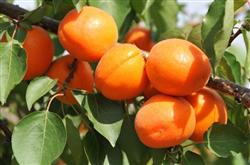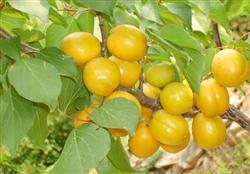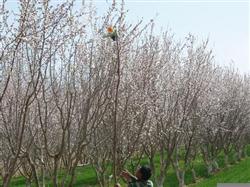Cultivation techniques of plum and apricot

The cultivation techniques of plum and apricot mainly include variety selection, planting, orchard management, shaping and pruning, pest control and overwintering protection. 1. Variety selection: the main varieties of plums are Suili No. 3, Suilenghong Li and Jilin No. 6. The main varieties of apricot are 631 apricot, Longken No. 1 apricot and Yilan apricot. The suitable varieties should be selected according to the local climate, temperature and soil quality. Second, planting: ⑴ seedling preparation. A sufficient number of seedlings with strong plants, full bud eyes and no diseases and insect pests should be prepared according to the plan before planting, which can be planted after soaking in water for one day and night. ⑵ land preparation. The land used for the establishment of an orchard must be deeply ploughed at a depth of 20-30 cm, leveled and raked fine in preparation for planting trees. Digging holes at ⑶ measuring points. According to the variety, topography technology, reasonable close planting spirit, determine the plant row spacing, generally plum row spacing 4 meters, plant spacing 2-3 meters. Under the condition of flat land, the row spacing of apricot trees is 4-5 meters and the plant spacing is 3-4 meters. Under the condition of barren mountain, the row spacing can be smaller. Configuration of ⑷ pollination tree. The self-flowering seed-setting rate of some varieties of plum and apricot is low, so the yield can be increased by configuring a certain number of pollination trees in addition to the main varieties. Pollination trees should choose varieties with cold resistance, high yield, good quality and consistent with the flowering period of the main varieties. Time and method of ⑸ colonization. During the planting period, the trees were planted with top pulp in the middle and last ten days of April, and the survival rate was high. The method of planting. In each pit before planting, 10-15 kg of rotten horse manure (sheep manure and pig manure) and 0.5-1 kg diammonium phosphate are fully mixed and put into the pit to form steamed bread, 20 cm from the surface of the pit mouth. When planting, put the interface of the seedling facing the windward, put it vertically into the center of the pit, flatten the root system around, and leave the interface on the ground surface. ⑹ irrigation. After the seedlings are planted, they should make a round water plate and irrigate immediately. Each plant should be irrigated with about a bucket of water. After the water has seeped, cover the tree trunk with dry soil or sand to prevent the water from evaporating and the topsoil from drying and cracking. Third, orchard management 1. Soil management of young orchards. There are many roots in the surface soil of young orchards, so it is beneficial to the growth and development of young trees to keep the soil loose. Therefore, it is necessary to carry out ploughing and weeding in time. Autumn ploughing should be the main way to cultivate the soil in the young garden. Usually in late September or early October. Combined with fertilization for autumn ploughing, the depth of 15-20 cm is appropriate. The scope of cultivation is larger than that of the canopy and can be expanded year by year. Spring ploughing is shallower than autumn ploughing, which is generally 10-15 cm. The closer it is to the tree trunk, the shallower it is to avoid root damage. 2. Soil management in mature orchards. ⑴ soil fertilization: ① fertilization period. Autumn fertilization can be carried out in late September and spring fertilization from late April to mid-May. The amount of fertilizer should be determined according to the actual situation of the orchard. General mature tree base fertilizer can be applied organic fertilizer 50-100 kg mixed with 0.1-1 kg diammonium phosphate per plant. ② fertilization method. One is to spread the fertilizer evenly on the surface of the ground, and then turn it into the soil, the depth of which is generally 20-30 cm. The other is circular fertilization, also known as circular fertilization, which takes the trunk as the center and takes the projection radius of the crown as the starting point. The ditch is 30 cm deep and 40 cm wide, and the mixed fertilizer is scattered evenly in the ditch and covered with soil. The third is the radial ditch fertilization method, which starts from the tree plate 1DUP 2, and the outer end is aligned with the outer edge of the crown. 6-8 radial ditches are dug, 20-30 cm deep, 40 cm wide, and the mixed fertilizer is scattered into the ditch to cover a layer of soil. In addition, there are ditch method, acupoint method and so on. ⑵ irrigation: ① irrigation period. According to the characteristics of water needs of plum and apricot trees, they are usually irrigated once before sprouting in early spring. During the fruit expansion period, water should also be irrigated once, at this time, irrigation can accelerate the growth and development of the fruit, not only protect the fruit, but also promote the growth of leaves and branches, which is conducive to the production and accumulation of nutrients. ② irrigation method. Tree disk irrigation method, around the tree trunk, make a round or square water plate, the range is smaller than the crown projection, the water into the plate, the amount of irrigation should be soaked in the root area of the soil is appropriate. ⑶ weeding, loosening the soil, removing roots and tillers. Shaping and pruning 1. Shaping and pruning of plum trees. According to the growth habits of plum trees, it is more appropriate to have a natural happy shape. The main branches are staggered and firm, and the inside and outside of the crown are well ventilated and transparent. The pruning period is divided into winter pruning and summer pruning. Winter pruning in Huanan County can be carried out in March and summer pruning can be carried out from June to early July. Pruning of plum trees at different ages: ⑴ young tree shaping. The pruning of young trees is mainly plastic surgery. When the seedlings are planted, a certain height from the ground, the flat ground is generally 60-70 cm, the mountain dry height can be appropriately lower, 50-60 cm is more appropriate. ⑵ pruning mature plum trees. It should be carried out by the combination of thinning and truncation, truncating the annual branches, which is not only beneficial to the growth of branches, but also expand the crown and maintain the tree potential. In the degree of pruning, the pruning degree is a little heavier, and the first stroke of the cut branch is stronger than the third. According to the location of the branch, the extended branch should be slightly longer, and the lateral branch should be appropriately shorter. 2. Shaping and pruning of apricot trees. ⑴ young tree shaping and pruning: according to the growth habits and fruiting habits of apricot trees, the natural round head shape should be better. There are 5-6 main branches in the whole tree with an angle of about 50 °and a certain distance between the main branches. ⑵ adult tree pruning: for trees in full fruit period, pruning should be emphasized appropriately to prevent the inner chamber from moving outward, the outer dense branches should be properly thinned, and the dead branches should be thinned in time, so as to facilitate ventilation and light transmission. ⑶ pruning of senile trees: strong pruning of senile trees, planned renewal of main branches, retraction and pruning of senile main and lateral branches, stimulation of latent bud germination and cultivation of healthy branches. Fifth, pest prevention and control. The pest control of plum and apricot is mainly chemical control. In the active stage of mature larvae at the end of April and the beginning of May, 50% phoxim emulsion was sprayed 30-50 times under the canopy with a dosage of 1 kg / 66TM2. Shallow raking of soil after spraying can not only eliminate adults unearthed by Eclosion of larvae, but also prevent phoxim emulsion from being decomposed by light. In addition, when the adults are in full bloom in June and July, 40% dimethoate emulsion or 2.5% deltamethrin (dimethrin) 2000 times can be sprayed on the trees, and 25% carbendazim or 65% Dysen zinc can be sprayed once in about 5 days. VI. Overwintering protection. The overwintering protection of trees is extremely important. In particular, whether the bark of the trunk and main branch is healthy or not is directly related to the tree potential, tree life and yield. Strengthening the protection of the bark of the trunk and main branches of plum and apricot can reduce sunburn, freezing injury, diseases and insect pests. Methods such as white coating, grass wrapping and root neck soil cultivation are commonly used to reduce or avoid bark damage caused by variable temperature or low temperature.
- Prev

Production technology of green fruit and early-maturing apricot
June is the ripe picking period of apricot fruit and the physiological differentiation and formation period of flower bud, and it is also the high incidence period of many diseases and insect pests. It is important to improve the quality of apricot fruit, promote flower bud differentiation and control diseases and insect pests. First, proper pruning: first of all, thinning out dense branches, picking the retained new shoots, so that you can...
- Next

About the most important summer pruning of apricot trees
In view of the low fruit setting rate of apricot trees in greenhouse, it is suggested that growers should grasp the artificial pollination at flowering stage from three points when cultivating apricot trees in greenhouse. The specific methods are as follows: 2-4 days before artificial pollination, buds with budding and normal development were collected from selected varieties with high pollination affinity.
Related
- Moge, come on! The staff of the peasant association in the producing area of cantaloupe were frightened when the crowd gathered.
- Causes and Solutions of low Fruit setting rate of Apple
- Symptoms and control measures of passion fruit virus disease
- Fruit growing lesson: how do apple orchards keep high yields?
- Can you build orchards in the mountains? What are the pros and cons?
- How to manage the coloring period of Crisson grape?
- This paper introduces the processing technology of two kinds of fig products.
- How much is a month for retired teachers in rural areas by 2020?
- How can strawberry planting increase sugar content? We should pay attention to management in many aspects.
- What are the cultivation techniques on how to improve the yield of golden fruit?

